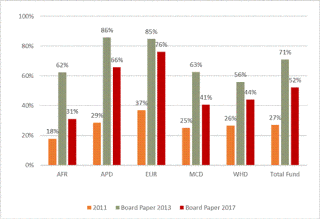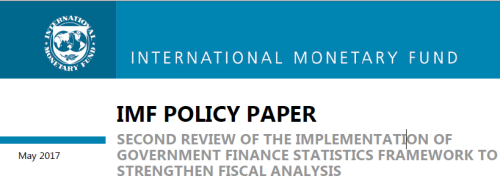Posted by Majdeline El Rayess and Zaijin Zhan[1]
A recently published policy paper by the IMF presents the second review of the implementation of the government finance statistics (GFS) framework in reports prepared by IMF staff. It follows the first review that was published in 2013, and calls for a continuation of the strategy approved by the IMF Board in 2010 to implement the Government Finance Statistics Manual 2001.
The policy paper shows that the presentation of GFS data in staff reports has decreased in 2017 compared to the 2013 review, although progress since 2011—the year following the 2010 Board decision—has been noticeable (see the chart below). In addition, staff reports are disclosing less balance sheet data, while the coverage of fiscal data has slightly improved, especially coverage of the general government sector. The paper identifies the various challenges that have led to a reduced level of reporting. These challenges include lack of familiarity of some countries with GFS concepts and practices, and technical difficulties in setting up fiscal databases.
The paper also discusses the resources that the IMF has used to support capacity building in countries to implement the GFS framework. This capacity development effort, which consists of training activities and technical assistance missions, has been increasing in recent years. However, a deeper and more sustained engagement over a period of years will be required to improve the coverage, timeliness, and quality of fiscal data.
The paper emphasizes how the GFS framework can be used to support the IMF’s work on fiscal surveillance and fiscal transparency. For example, the IMF’s 2014 Triennial Surveillance Review called for the use of balance sheet analysis to convey vital information about economic prospects and risks. And the Fund’s Fiscal Transparency Code includes direct references to the GFS framework in defining the Code’s principles and standards of practice in fiscal reporting.
Figure. Status of Implementation of the GFS Presentation in Staff Reports


Key: AFR = Africa Region; APD = Asia Pacific region; EUR = European region; MCD = Middle East and Central Asia region; and WHD = Western Hemisphere region
Finally, the paper puts forward several recommendations for further tailoring the implementation of the GFS framework to national capacity and surveillance needs. Rather than using a uniform approach, this paper proposes: i) developing a strategy to implement the GFS which would be tailored to countries’ fiscal surveillance needs; ii) encouraging the IMF’s country teams to continue their effort to routinely assess financial balance sheets during surveillance operations; iii) gradually expanding the coverage of fiscal data, taking into consideration country-specific circumstances and fiscal risk assessments; and iv) reaffirming the Fund’s support for the phased implementation of the GFS framework over the medium term.
[1] Madjeline El Rayess is an Economist in the Fiscal Affairs Department of the IMF; and Zaijin Zhan is a Deputy Division Chief in the IMF’s Statistics Department.
Note: The posts on the IMF PFM Blog should not be reported as representing the views of the IMF. The views expressed are those of the authors and do not necessarily represent those of the IMF or IMF policy.






